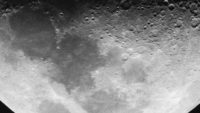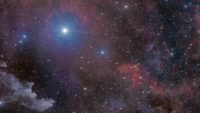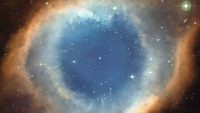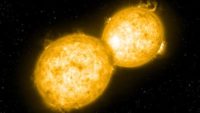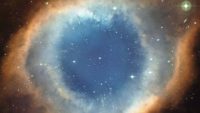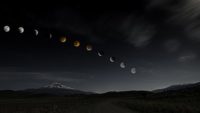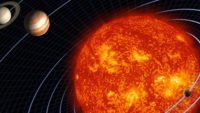The recent discovery of thirty new exoplanets in other solar systems presents another challenge to the most popular secular theory of planet formation.1,2 These exoplanets are smaller versions of our gas giant Saturn. A recent survey shows that these intermediate gas giants are ten times more common than predicted by the secular theory.3 One of these intermediate gas giants, designated O… More… …read more Source: icr.org
By Dr. Danny R. Faulkner What do lunar eclipses tell us about flat earth? Lunar eclipses remain the best method for most people to see for themselves that the earth is a sphere. …read more Source: AIG Daily
Saturn’s gravity keeps vacuuming up its own stunning rings. NASA scientists have estimated how fast this process happens. The rings lose six Olympic-sized swimming pools-worth of material every hour according to new results from NASA’s Goddard Space Flight Center.1 For this and other reasons, scientists have concluded that the rings are unlikely to be more than 100 million years old. These rings look young, forcing sc… More… …read more Source: icr.org
The evolutionary timeline has a problem: Saturn’s icy rings are too ‘pristine’. …read more Source: creation.com
By Dr. Danny R. Faulkner What’s up in 2019? The year begins with a bang, for on the morning of January 1, the moon and Venus will be close together in the sky. …read more Source: AIG Daily
By Dr. Don DeYoung There have been many attempts to explain the Christmas Star scientifically, and three will be mentioned here. …read more Source: AIG Daily
When it comes to explaining how our universe came into being, widespread speculation is embraced over hard evidence. …read more Source: creation.com
By Dr. Danny R. Faulkner Flat-earthers argue that since certain verses in Scripture speak of the stars falling, then the stars will literally fall. …read more Source: AIG Daily
After speaking at a church recently, a young man approached me. I thought he might have a question. Instead, he handed me a 6-page essay he had written. It was a defence of a form of Day-Age creationism, the belief that the days of Genesis were actually long periods of time. Normally, I would not spend too much time on such a thing, but the young man impressed me as humble and studious. He also reminded me of myself at that age, when I was trying to defend that very same position. But when I read his paper, I saw [More]
By Ken Ham A short article appeared recently in an “Ask a Scientist” column in response to the question, “How did the Big Bang begin?” The scientist explains, “The Big Bang Theory is a timeline of the history of the universe. It says nothing about how the universe was created. As such, there is no beginning to the Big Bang, since it is a theory that merely describes the universe’s history.” He goes on to explain that in the Big Bang model (which he wrongly refers to as a theory, as there’s no observational evidence to support it), the entire [More]
A scientific study aligns with the biblical account of the ancient cities of Sodom and Gomorrah being destroyed by fire and brimstone from the heavens. The book of Genesis tells the story of God sending two angels to save Lot and his family from a city where men demanded to “be intimate” with visiting men, one of the clearest biblical condemnations of homosexuality. In response, God “rained upon Sodom and Gomorrah sulfurous fire … out of heaven.” It would be hundreds of years before life returned to the region. And now scientists have found evidence of a cataclysmic event in that area, [More]
In a universe allegedly billions of years old, some clearly visible star features should not exist. Read More
Secular scientists claim that stars form “naturally” from enormous clouds of gas and dust. The newly-formed star is thought to be encircled by a thin, slowly-spinning disk of dusty material. Dust particles within the disk are thought to collide and stick together, through a hypothetical process called accretion, somehow forming more massive clumps of matter over vast amounts of time. These clumps become the cores of future plane… More… …read more Source: icr.org
By Dr. Danny R. Faulkner It’s ironic that the very thing that supposedly is the proof of the big bang model may turn out to be its undoing. …read more Source: AIG Daily
When did stars explode, and how can we see their light under a biblical time frame? Are they compatible with a very good creation? …read more Source: creation.com
Could solar superflares have made the supposed ‘early’ Earth inhospitable for life? Read More
By Dr. Danny R. Faulkner Creationists frequently quote Hubble to the effect that he inserted the cosmological principle to avoid stark realties about the universe that his data implied. …read more Source: AIG Daily
By Dr. Ron Samec After 29 years of research, a creation astronomer has observable evidence that stars can’t be billions of years old. …read more Source: AIG Daily
Astronomers claim they have found a protoplanet forming around a young star, but not so fast. …read more Source: creation.com
By Harry F. Sanders, III Dr. Danny Faulkner’s recent Answers Research Journal article makes a number of important points about redshifts, quasars, and an expanding universe. …read more Source: AIG Daily
By Dr. Danny R. Faulkner Flat-earthers spend considerable time and effort attempting to debunk all things from NASA. In this article, I will take up two of their complaints. …read more Source: AIG Daily
Saturn is too hot for its evolutionary age. It should’ve cooled off if it were 4.5 billion years old. What can we learn about the age of the universe from our solar system? How can biblical creationists confidently assert a young age for celestial objects like blue stars? Listen: The Institute for Creation Research
Naturalistic assumptions can get in the way of understanding the origin of solar system objects. Read More
By Dr. Danny R. Faulkner Sights like a lunar eclipse are possible only because of our moon’s unique relationship to the earth. …read more Source: AIG Daily
Oxford scientists cast doubt on intelligent life outside Earth; Elon Musk says this is all the more reason to colonize space. …read more Source: <a href=http://creation.com/dissolving-fermi-paradox target=_blank title="Dissolving the Fermi Paradox” >creation.com
By Dr. Danny R. Faulkner June 30 is International Asteroid Day. It’s an opportunity to talk about asteroids and a good time to discuss a recent item in the news related to asteroids. …read more Source: AIG Daily
A look at the problems associated with evolutionary origin-of-life scenarios for our world. …read more Source: creation.com






















